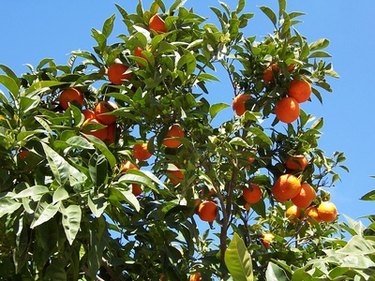
Tangerines (Citrus reticulata) were once the favored fruit to tuck into a child's stocking at Christmas – that or a lump of coal. The winter harvest of tangerines is a time for celebration as grocery stores display boxes and netting filled with the orange fruit, and children and adults alike peel the thin rinds and swoon in ecstasy at the sweetness permeating their mouths – the result of careful citrus care. Pruning citrus and tangerine trees is one of the steps taken during the growing season to ensure the trees produce a large quantity of fruit.
Pruning Tangerine Trees
Video of the Day
Tangerine trees produce best when grown in U.S. Department of Agriculture plant hardiness zones 8b-11. Unless the tree has suffered cold damage, citrus and especially tangerine trees are pruned in the spring before the buds appear and after the last fruit has dropped. The months of February through April are the recommended months to prune. The tangerine tree is susceptible to sunburn, which is why it is critical to examine the branch growth before putting trimmers to limbs.
Video of the Day
Stand back from the tree and visually inspect its growth. If you had little fruit from the center of the tree, it needs to be opened up to let sunlight and air come through. Starting on the north side of the tree where the less intense light comes through, cut a path from the center outward. Look for branches that overlap and choose the healthiest to remain. Examine the canopy and if the branches are helter-skelter, reshape it. Cut where the branch meets the trunk in a downward, angled movement.
Cleaning Up the Stragglers
As you examine the interior of your tangerine tree, you'll notice suckers, shoots, dead branches and twigs. Cut them off and leave only the healthy growth. Then, stand back again and see how clean the lines of your tree are becoming. Pay attention to the tree's height for easier harvesting and trim as necessary.
Light also penetrates the interior branches from above. You've made a window from the north through the tree and now you need to make one that allows direct sunlight to pass through from above. Find the branch with a lot of leaves and choose it to be cut. You aren't sacrificing fruit; you're just making it easier for more fruit to be made. If the branch is more than 1 inch in diameter, paint the cut mark with pruning sealer. Pruning only needs to be done once a year, with maintenance snips during the year.
Pruning Cold-Damaged Citrus
If the tangerine tree has been damaged by cold or a freeze, do not prune immediately. Instead, observe the reactions of the branches to see if they split, become loose or ooze. New growth or lack thereof will become evident by summer. Cut the damaged limbs or branches until you reach healthy wood. Seal the wound with a pruning sealant. Do not trim from November through January, as pruning stimulates new growth, and the cold winter months will damage the tender limbs.
If the trunk of the tree is exposed to either the hot summer sun or freezing winds and the canopy sits high above the trunk, paint it with a latex paint diluted to 50 percent, creating a whitewash. This protects the tree from debilitating weather.